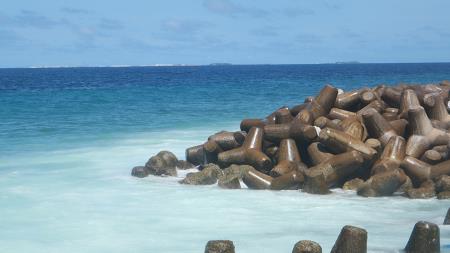Walking on the outskirts of the dense concrete jungle Malé City, ever notice the damp barricades on the outer coast encircling all around the city? Not less of a fort, the tripod structured concrete rock based sea wall was aided by the Japanese in 1991, as one of the very first implications for the fight against global warming. Indeed, building a seawall will not affect the rate of global warming, but with the high- end risk that the Maldive islands face, this “band-aid” is the sole reason for the survival of the concrete town.
Popularized as the Bajiyaa Gaa (“Bajiyaa” is a triangular shaped Maldivian short-eat, also an alternative to the Indian Samosa, while “Gaa” translates to “Rock”), the central sea-wall was granted due to the dense Maldivian population residing in the capital with over 64,000 in the 1990s. Before the sea-wall, large coastal tides damage sewage systems and constantly flood half the city during the stormy monsoon. This caused a major Cholera outbreak in the capital due to water contamination while destroying vegetation and coastal structures (harbour erosion).
With the seawall built, the Malé streets became drier, helping initiate the paving project of the city streets. The dangerous waterborne disease-free town was not the only achievement, as the seawall had reduced the impact of the 2004 Indian Ocean Tsunami. The eastern coast of Malé City was guard-less to the Earthquake core at Sumatra, with no land resisting the waves in between. Even though the tsunami had flooded the city, there was minimal damage in the city while the rest of the 199 inhabited islands suffered gravely. The protected city became a refugee camp to the victims all across the twenty atolls, until temporary homes were built for the people.
Home for the local crabs, the Bajiyaa Gaa seawall is an expensive but important preventive measure for islands from events that arise from climate change. Similar sea-walls are being built across many inhabited islands without the tripod structure, making Malé City one of the only sites to view this protective umbrella.

 Dashboard
Dashboard
 Settings
Settings
 My Profile
My Profile
